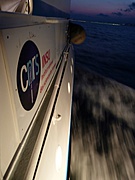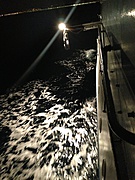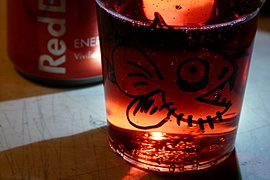Nocturnal observations
by Martin Lilley, on
One of the secondary aspects of the VISUFRONT cruise has been to collect surface observations of jellyfish. The common Scyphozoan jellyfish species in the Ligurian Sea is the Mauve Stinger (or Méduse Rose in French) Pelagia noctiluca. This species has been present within the Mediterranean for at least 100 years and has periods of high abundance alternating with several years of low abundance. The species arrives on the coasts throughout the year, but attracts considerable media attention by tourists and swimmers being stung in the summer. Throughout the Mediterranean it is perceived as a problem species, but despite long observational records very little is known about the biomass of the species or even how long it lives. The research from VISUFRONT will go some way to providing a wider spatial view of this species.
Unfortunately for the researchers, Pelagia seems to respond to light and spend the day deep in the water (possibly as deep as 700m), coming to the surface at night in large numbers to feed. Even the light of the moon is sufficient to send it swimming down into the depths if exposed to it for too long. Only those animals arriving close to shore, possibly in poor condition appear to respond less towards the light. So to observe these animals the use of a spotlight and work during the night hours (currently 21:30-05:00) is required. The team from the L'Observatoire in Villefranche-sur-Mer took turns with Leo Berline, Fabien Lombard and Martin Lilley alternating to observe the night-sea.
Within the light of the spotlight, halfway back along the side of the boat, you can see about 40 m2 at a time. The aim is to count the number of Pelagia passing this ‘window' and record the changing physical conditions of the sea on a regular basis. Observations at the 4-knot cruising speed of ISIIS are relatively easy as long as there aren't large waves, but faster speeds or a swell make the conditions more difficult. At times you find yourself being mesmerised by empty green-blue moving water, and are then brought back to reality by the arrival of a jellyfish. These calm times were rare, unless we were observing before dusk, and 5-50 jellyfish were common in a five minute period. At times there was a carpet of jellyfish all facing different ways at the surface, using their long tentacles to fish plankton, and competing for space. When this is the case you are forced to count in 10s, 20s or 50s at a time and the numbers rack up to over 1000 individuals on several occasions.
The night-time labour is not without reward as you spend so much time staring at the sea occasionally other organisms are either surprised or attracted to the light source as it goes by. Small fish seem to use the light to hunt, Sunfish have been seen, and occasionally dolphins zip through the light on their way to play on the bow-wave. The downsides of course are prolonged periods staring at a moving sea, which can cause stomach upsets in those not acclimatised to the motion of the ship. Equally sleeping during the day can lead to disorientation and confusion as to what the day is, when the next meal will come and quotes like "is it morning?" and "See you ‘tomorrow', when I have slept". At times it is also hard to motivate yourself to continue on for another five minutes, without the use of energy drinks or caffeine.
All in all, it provides an opportunity to look into a world that few people have had the chance to observe and those coming to question the ‘compteur de méduse' have been frequently surprised to see the jellyfish. If you don't observe the world you'll just remain oblivious to that which is passing your port-hole. Personally though, it is possible to get too much of a good thing and I will be glad to get back to a normal schedule once again next week. It has provided plenty of food for thought and posed further questions about the life of these nocturnal creatures.


